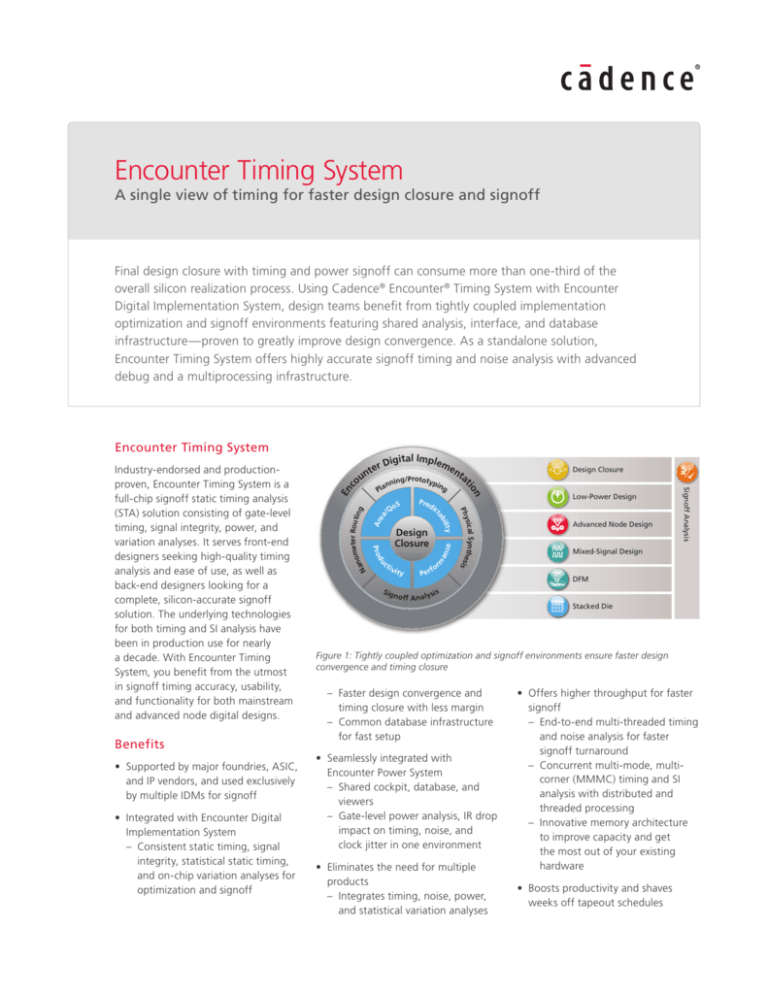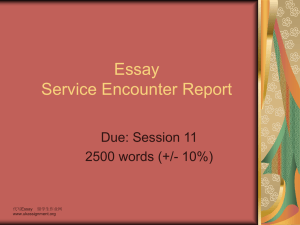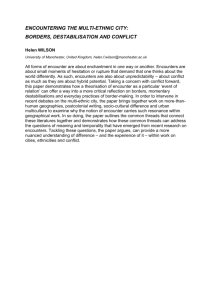
Encounter Timing System
A single view of timing for faster design closure and signoff
Final design closure with timing and power signoff can consume more than one-third of the
overall silicon realization process. Using Cadence® Encounter® Timing System with Encounter
Digital Implementation System, design teams benefit from tightly coupled implementation
optimization and signoff environments featuring shared analysis, interface, and database
infrastructure—proven to greatly improve design convergence. As a standalone solution,
Encounter Timing System offers highly accurate signoff timing and noise analysis with advanced
debug and a multiprocessing infrastructure.
ce
an
Sig
m
Are
a
eter Routin
nom
g
Na
iv i
ty
Pe
n o ff A n
r
rf o
Design Closure
Low-Power Design
Advanced Node Design
Signoff Analysis
Design
Closure
l Synthe
ysica
sis
Ph
ct
Pred
ic
n
tio
• Integrated with Encounter Digital
Implementation System
–– Consistent static timing, signal
integrity, statistical static timing,
and on-chip variation analyses for
optimization and signoff
oS
/Q
ity
bil
ta
• Supported by major foundries, ASIC,
and IP vendors, and used exclusively
by multiple IDMs for signoff
g
Pl
du
Benefits
lI
Digita mpleme
er
nt
nt
a
u
/Prototyp
o
ning
in
an
P ro
Industry-endorsed and productionproven, Encounter Timing System is a
full-chip signoff static timing analysis
(STA) solution consisting of gate-level
timing, signal integrity, power, and
variation analyses. It serves front-end
designers seeking high-quality timing
analysis and ease of use, as well as
back-end designers looking for a
complete, silicon-accurate signoff
solution. The underlying technologies
for both timing and SI analysis have
been in production use for nearly
a decade. With Encounter Timing
System, you benefit from the utmost
in signoff timing accuracy, usability,
and functionality for both mainstream
and advanced node digital designs.
En
c
Encounter Timing System
Mixed-Signal Design
DFM
is
alys
Stacked Die
Figure 1: Tightly coupled optimization and signoff environments ensure faster design
convergence and timing closure
–– Faster design convergence and
timing closure with less margin
–– Common database infrastructure
for fast setup
• Seamlessly integrated with
Encounter Power System
–– Shared cockpit, database, and
viewers
–– Gate-level power analysis, IR drop
impact on timing, noise, and
clock jitter in one environment
• Eliminates the need for multiple
products
–– Integrates timing, noise, power,
and statistical variation analyses
• Offers higher throughput for faster
signoff
–– End-to-end multi-threaded timing
and noise analysis for faster
signoff turnaround
–– Concurrent multi-mode, multicorner (MMMC) timing and SI
analysis with distributed and
threaded processing
–– Innovative memory architecture
to improve capacity and get
the most out of your existing
hardware
• Boosts productivity and shaves
weeks off tapeout schedules
Encounter Timing System
–– Industry-renowned global timing
debug accelerates root-cause and
bottleneck analysis
–– MMMC-aware debug quickly tracks
down timing problems across all
modes
–– MMMC- and SI-aware incremental
engineering change orders
–– Advanced analysis algorithms to
reduce false SI failures by 10x
• Unmatched signoff accuracy
–– Prevents the excessive overdesign
that saps performance, power, and
die area
–– Delivers accurate delay calculation to
within 2% of SPICE
–– Leverages current source models for
greater accuracy with advanced node
designs
–– Offers built-in critical path simulation
for delay/SI correlation with SPICE
Features
Encounter Timing System provides a
comprehensive signoff verification
solution that combines static timing
analysis (STA), accurate delay calculation, crosstalk noise analysis, advanced
modeling, and global timing debug.
It helps you achieve first-pass silicon
success and fast time to market on their
multimillion-gate designs. Encounter
Timing System also supports incremental
engineering change orders (ECOs) and
“what-if” analysis, reducing runtimes for
minor design changes and thus improving
productivity.
Powerful GUI
• Command console with command
completion, history, and context
highlighting
• Timing constraint viewer to find
path-specific timing constraints based
on design object name or constraint
group type
• Schematic and layout viewers with the
ability to cross-probe from the timing
report
www.cadence.com
SDC
.lib
VCD
Spice
DEF + LEF
SPEF/SDF
Verilog
ECSM
Encounter
Timing
System
Power
Reports
SDF
SDF
DRVs
Figure 2: Encounter Timing System data flow and user interface
• Script editor for evaluating scripts
to enable cross link and expand Tcl
procedures
• Structural checks on timing paths to
identify potential issues
• Checks for missing or inconsistent
library and design data
Consistent, integrated STA for
optimization and signoff
Designers have traditionally relied on
one STA method for implementation
and another for signoff analysis. This
leads to corrective iterations with the
place-and-route system when discrepancies are found during signoff analysis.
Encounter Timing System is a consistent,
integrated STA environment for optimization during the place-and-route stage
and for final signoff verification. This gives
you the flexibility to use Encounter Timing
System as a standalone solution or as
part of the integrated Encounter Digital
Implementation System.
Global timing debug
With global timing debug, you can quickly
pinpoint the root cause of timing and
constraint problems. You can view the
slack histogram and generate detailed
timing views with individual cell/wire
delays, slack details, hierarchy allocations, and constraint cross-probing.
Global timing debug employs unique path
visualization capabilities to determine
a path’s cause of failure. Paths that
share a common failure mode can then
be categorized dynamically while the
debugging of “uncategorized” paths
continues. Path categories can be
visualized in the global timing context
to determine which categories can be
“fixed” in parallel and which ones should
be fixed first. This reduces iterations to
timing closure by intelligent debugging
more than just the worst path.
Global clock debug
With global timing debug, you can quickly
pinpoint the root cause of timing and
constraint problems. You can view the
slack histogram and generate detailed
timing views with individual cell/wire
delays, slack details, hierarchy allocations, and constraint cross-probing.
Global timing debug employs unique path
visualization capabilities to determine
a path’s cause of failure. Paths that
share a common failure mode can then
be categorized dynamically while the
debugging of “uncategorized” paths
continues. Path categories can be
visualized in the global timing context
to determine which categories can be
“fixed” in parallel and which ones should
be fixed first. This reduces iterations to
timing closure by intelligent debugging
more than just the worst path.
2
Encounter Timing System
Advanced nanometer electrical
analysis
Implementing multimillion-instance
nanometer designs requires very efficient
yet highly precise delay calculation.
Designers must also consider SI effects
such as IR drop and crosstalk, and
advanced low-power design techniques
that use multiple voltage levels and level
shifters. Delay calculation based on table
lookup or polynomial models are not
accurate enough for today’s nanometer
circuits. Encounter Timing System
supports the effective current source
model (ECSM), which enables accurate
prediction of actual silicon performance,
particularly for complex nets, long RC
networks, and multiple driver scenarios
(clock meshes).
Figure 3: Global timing debug
Global clock debug
Fast, Accurate Signoff
With global clock debug, you can see
the clock structure and quickly get to the
root of clock-related problems. You can
quickly determine if there are issues with
the specifications, clock re-convergence,
skew, transition time, or insertion delay—
and get relevant physical information
on how to fix them. You can display the
graphic structure of a large and complex
clock structure as needed, folding or
unfolding the clock tree at any stage
to tune into the relevant information,
without being overwhelmed by other
details.
Encounter Timing System offers accurate
analysis of signal integrity (SI) and IR drop
as well as its impact on both timing and
functionality. It builds on the strengths
of the customer-trusted, tapeout-proven
Cadence CeltIC® Nanometer Delay
Calculator (NDC) engine. And it employs
more accurate libraries (ECSM, cdB) to
analyze the complex effects of crosstalk
delay, noise (glitch), timing, and IR drop.
Accurate crosstalk analysis and faster
SI closure
Encounter Timing System calculates the
impact of crosstalk using a combination
of cell- and transistor-level models. For
noisy nets that exhibit the most non-linear
behavior, Encounter Timing System uses
an on-the-fly SPICE simulation engine
to accurately calculate noise-on-delay
effects. It also deploys the unique pathbased alignment (PBA) technique to
ensure realistic SI delay effects on critical
Interface to Encounter Conformal
Constraint Designer
A seamless interface between Encounter
Timing System and Encounter Conformal®
Constraint Designer enables advanced
constraint checking and critical false-path
analysis. Constraint checking eliminates
bad constraints that cause iterations,
longer design time, and silicon failure.
Critical false-path analysis greatly reduces
the need to manually remove false paths
from the critical paths. Removal of these
false paths eliminates unnecessary netlist
optimizations and can improve design
area and timing.
www.cadence.com
Figure 4: Global clock debug
3
Encounter Timing System
crosstalk failure. Encounter Timing System
accurately models the non-linear IR drop
impact and eliminates the inaccuracies of
the traditional linear K-factor approach.
It incorporates instance-based IR drop
data from Cadence VoltageStorm® Power
Verification to account for the effects of
static and dynamic IR drop on path delays
and SI.
Reported SI Violations
10000
90nm
130nm
65nm
45nm
# of Violations
1000
100
10
1
499k
39.5k
2.7M
810k
184k
1.3M
682k
ETS XL
Propagated
1
8
18
1
1
14
25
No
Propagation
29
49
496
272
5
31
4400
Figure 5: SI pessimism reduction and critical path simulation
timing paths. Without PBA, SI delay
calculation can create an unrealistic or
overly pessimistic worst-case path delay.
Further removal of path delay pessimism
is achieved through noise path pessimism
removal (NPPR), which finds the maximum
noise delay change for the overall critical
path instead of for each individual net on
that path.
Encounter Timing System also ensures
functional validity by performing glitch
noise propagation to register end points
and by ensuring that the register is not
driven unstable. These unique PBA,
NPPR, and glitch noise propagation
capabilities greatly reduce the number of
false crosstalk problems. This translates
into much less work for place-and-route
systems and significantly fewer SI closure
iterations.
Automated MMMC signoff and ECO
Encounter Timing System’s unique
multi-mode multi-corner (MMMC) infrastructure enables you to quickly analyze
and debug timing problems across all
modes and corners. It features concurrent
MMMC analysis with distributed and
threaded processing capability that
provides simplified management of
MMMC runs coupled with the highest
possible throughput. This is complemented by the MMMC-aware incremental engineering change order (ECO)
capability, which allows you to make an
ECO and see the effect on timing and
SI across all modes in a single session,
without running additional reports or
scripts.
www.cadence.com
Multi-processing architecture
Encounter Timing System utilizes both
threaded and distributed processing
to greatly improve overall signoff
turnaround. Through threaded timing and
SI analysis, you can gain up to four times
the performance over a single CPU run. In
addition to threading on a single machine,
Encounter Timing System includes MMMC
timing analysis and “superscaling”
SI analysis, which can be distributed
across multiple machines. By distributing different parts of a task between
two or more processors, Encounter
Timing System can significantly improve
turnaround time and handle larger, more
complex designs.
Unified power analysis
Encounter Timing System provides a
comprehensive static and dynamic
solution for cell-level power analysis by
combining timing and power analyses
in a single environment. This integrated
environment delivers faster results and
improves your productivity. Encounter
Timing System supports both vectored
and vectorless approaches to power
analysis. The vectorless approach enables
accurate power analysis early in the
design flow, while vectors are used to
achieve the highest accuracy.
Low-power–driven signoff
In smaller geometries, power supplies
are typically around 1 volt, and even
small voltage drops can compromise
signal timing and lead to chip failures.
IR drop further increases the risk of
Advanced low-power design techniques
such as multi-supply/multi-voltage
(MSMV) and dynamic voltage and
frequency scaling (DVFS) can introduce
errors and complicate the traditional
timing signoff flow. Encounter Timing
System enables a simple flow where you
can characterize just three libraries at
three voltage points, which are sufficient
to perform accurate non-linear delay
calculation across a much wider range of
voltage points. Encounter Timing System
also supports the Common Power Format
(CPF), which describes power intent
throughout the design flow from system
specification to tapeout.
Critical path simulation
Encounter Timing System enables on-thefly path simulation of critical paths and
offers a graphical view of the impact of
crosstalk and IR drop along the path,
including the propagation of non-linear
waveform effects. This enables easy
validation of timing, SI, and IR drop
effects—and verification of fixes—prior to
implementation.
Comprehensive variation support
At 65nm and below, process control
becomes very difficult. Manufacturing
variations result in deviations in electrical
behavior for devices and interconnect.
Traditionally, these variations have been
factored into the design flow by adding
bulk margin to the timing constraints or
libraries. But this practice can negate the
advantages gained from using smaller
process nodes over larger process nodes.
In addition, designs required only to
pass traditional signoff standards could
still fail in silicon if the corners are not
chosen properly.
4
Encounter Timing System
Encounter Timing System enables you
to properly analyze and account for
process variation without resorting to
excessive margins or overdesign to restore
predictability to the design flow. It offers
common-path pessimism removal (CPPR),
advanced on-chip variation analysis,
statistical static timing analysis (SSTA),
and statistical leakage and thermal
analyses to achieve maximum design
performance with minimum power
consumption at advanced process nodes.
These technologies help reduce the
design cycle with fewer timing runs and
help you tape out with greater confidence.
Location-based on-chip variation
Designers must address on-chip variation
(OCV) effects, including removal of
pessimism caused by common paths.
However, traditional OCV analysis is
inaccurate and overly pessimistic since
it employs a constant de-rating factor.
Encounter Timing System employs
location-based on-chip variation (LOCV),
which uses logic level, cell complexity,
and physical location to select the optimal
de-rating factors. LOCV helps eliminate
the excessive guardbanding associated
with traditional de-rating, and it improves
timing closure.
Statistical static timing analysis
Traditional STA accounts for process
variations by introducing more aggressive
gross guardbanding and by using multiple
analysis corners to model different
process and environmental variation
combinations. This corner-based approach
can be overly pessimistic since it reports
timing scenarios that have an extremely
small likelihood of occurring. Also, the
exponential growth in the number of
corner combinations with the increasing
number of parameters makes analysis on
every corner impractical.
Encounter Timing System supplements
traditional corner-based methods with
powerful and accurate statistical static
timing analysis (SSTA) that can account
for the process variability in a single run.
www.cadence.com
It uses advanced statistical ECSMs to
identify cells and nets on both clock and
data paths that are sensitive to variations. It also determines the probability
of timing failure over the full range of
process variation. These features reduce
both pessimism and guardbanding,
resulting in decreased area and power
consumption while improving chip performance. Encounter Timing System lets
you explore potential tradeoffs between
parametric yield and clock speed.
and introduce timing failures across the
die. Simply applying more guardbanding
to your design to account for this variation
can negatively affect chip performance.
Encounter Timing System includes a
powerful thermal analysis engine that
takes chip packaging into account and
provides an accurate thermal map and
per-instance temperature. This reduces
the need for more guardbanding and
enables you to target thermal hotspots
more effectively.
Encounter Timing System SSTA features
include:
Statistical leakage power analysis
• Within-the-die, die-to-die, and random
variation support
• Block-based and path-based modes
• Crosstalk noise impact
• Standardized statistical ECSM library
models and characterization support
• Consistency and integration with
Encounter Digital Implementation
System to fix variation problems
automatically
Thermal analysis
Designers targeting advanced node
processes are quickly discovering that
on-chip thermal variation can no longer
be ignored. Thermal impact at smaller
process nodes can affect leakage power
At smaller process geometries, leakage
power begins to dominate the power
consumed by CMOS devices. Accurate
analysis of device leakage is paramount
to achieving a power-efficient design.
Existing leakage power analysis
techniques use a pessimistic worst-case
approach, which is ineffective. Since cell
leakage has an exponential response to
process variation (that is, a small change
in process variation causes a major shift
in transistor leakage), the probability
of the extreme worst case occurring in
real silicon is very small. This leads to
aggressive over-design, overcompensation
for IR drop, and potentially unnecessary
architectural changes. The solution is to
model the leakage power as a statistical
probability to avoid designing to the
worst-case limit.
SDC
Spice
.lib
VCD
SPDF
DEF + LEF
SPEF/SDF
Verilog
S-ECSM
Encounter
Timing
System
Power
Reports
SDF
Statistical
Reports
DRVs
Figure 6: SSTA data flow
5
Encounter Timing System
The statistical leakage power analysis
(SLPA) of Encounter Timing System helps
you target a smaller, more reasonable
leakage number. This number reported by
statistical analysis can be as much as 40%
smaller than that of traditional worst-case
leakage power analysis. Using advanced
statistical ECSMs, Encounter Timing
System can model the following:
• State-dependent exponential leakage
power variation with respect to process
parameters
SLPA
Spice Monte Carlo
3 -s igma L eakage
(99.7% confidenc e)
Up to 200% Difference
0
15000
25000
35000
45000
55000
Leakage (nW)
• Die-to-die, within-the-die (spatially
correlated), and random variation
Platforms
Figure 7: Statistical leakage power distribution
• Linux: 32-bit, 64-bit
Packaging
• Sun Solaris: 64-bit
Encounter Timing System is available in L
and XL base licenses with an Advanced
Analysis GXL Option.
• IBM AIX: 64-bit
Standard Interface Support
Cadence Services and Support
• Inputs
–– Verilog, .lib, SDC, SDF, SPEF, Tcl
–– Optional: ECSM, cdB, DEF, CPF, OA,
VCD, OCV
–– SSTA: Statistical ECSM (S-ECSM),
Statistical SPEF (S-SPEF), Statistical
Parameter Distribution File (SPDF)
• Cadence application engineers can
answer your technical questions by
telephone, email, or Internet—they can
also provide technical assistance and
custom training
• Outputs
–– Timing reports, SDF, DRV report,
power reports
Worst-Case
L eakage
• More than 25 Internet Learning
Series (iLS) online courses allow you
the flexibility of training at your own
computer via the Internet
• Cadence Online Support gives you 24x7
online access to a knowledge base of
the latest solutions, technical documentation, software downloads, and more
• Cadence certified instructors teach
more than 70 courses and bring
their real-world experience into the
classroom
Cadence is transforming the global electronics industry through a vision called EDA360.
With an application-driven approach to design, our software, hardware, IP, and services help
customers realize silicon, SoCs, and complete systems efficiently and profitably. www.cadence.com
© 2011 Cadence Design Systems, Inc. All rights reserved. Cadence, the Cadence logo, CelHC, Conformal, Encounter, and VoltageStorm are
registered trademarks of Cadence Design Systems, Inc. All others are properties of their respective holders.
21298 09/11 KM/DM/PDF








